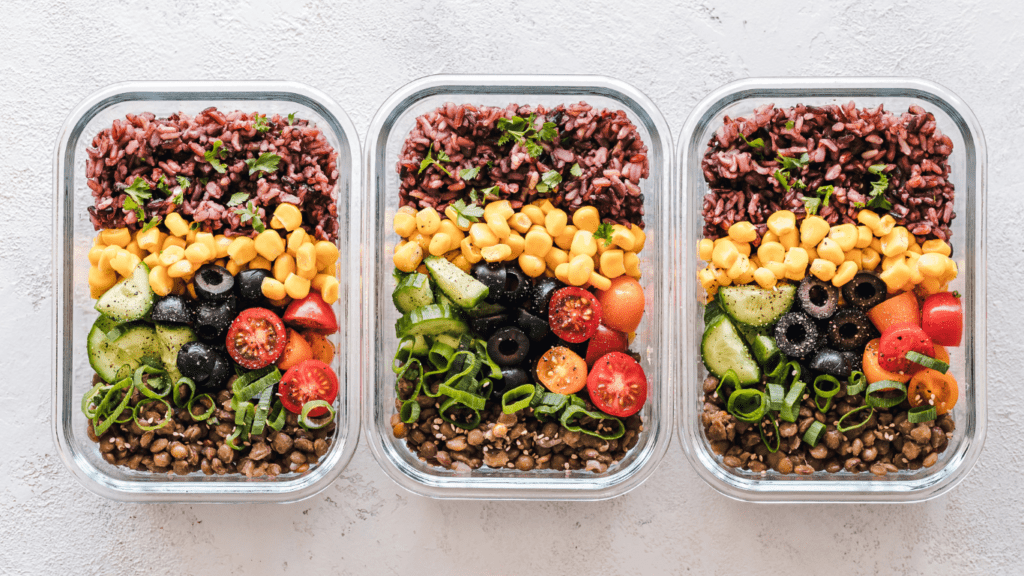Understanding Balanced Meals
Balanced meals incorporate essential nutrients in appropriate ratios. They provide carbohydrates, proteins, fats, vitamins, and minerals, each critical for health. Carbohydrates (e.g., whole grains) are the body’s primary energy source. Proteins (e.g., lean meats) support tissue repair. Fats (e.g., avocados) aid in nutrient absorption. Vitamins and minerals (e.g., fruits and vegetables) boost bodily functions.
Proportions matter in a balanced meal. A healthy plate includes half fruits and vegetables, a quarter lean proteins, and a quarter whole grains. This simple model simplifies portion control and ensures diverse nutrient intake.
Diverse food options expand meal plans. Selecting a variety of sources within each nutrient category prevents nutrient deficiencies. For instance, rotating protein sources like fish, beans, and poultry delivers a broader nutrient spectrum.
Key Components of a Balanced Meal

Balancing meals requires an understanding of the different nutrients necessary to support a healthy body. Every meal can include proteins, carbohydrates, fats, vitamins, and minerals in the right proportions.
Proteins
Proteins are essential for repairing tissues and building muscles. Aim to include a variety of protein sources in meals, such as lean meats, fish, beans, and legumes. These sources offer a range of amino acids and help maintain a balanced diet. Choosing a mix of animal and plant proteins provides essential nutrients while supporting sustainable eating habits.
Carbohydrates
Carbohydrates provide the body with energy. Opt for whole grains like brown rice, whole wheat bread, and oats, which offer more fiber and nutrients than refined grains. Including fruits and starchy vegetables like sweet potatoes ensures a continuous energy supply throughout the day. This variety supports digestive health and keeps energy levels stable.
Fats
Fats play a crucial role in nutrient absorption and hormone production. Focus on healthy fats from sources like avocados, nuts, seeds, and olive oil. These fats provide essential fatty acids beneficial for heart health. Limiting saturated and trans fats from processed foods and fatty cuts of meat contributes to a more balanced meal plan.
Vitamins and Minerals
Vitamins and minerals support various bodily functions, from bone health to immune response. Ensure meals include a rainbow of colorful fruits and vegetables to cover a broad spectrum of these micronutrients. Including dark leafy greens, berries, citrus fruits, and peppers enhances nutrient diversity. Regularly rotating different types of produce also prevents nutritional gaps and boosts overall well-being.
Portion Control and Its Importance
Portion control directly influences a balanced meal’s effectiveness. Each meal includes correct portion sizes and avoids overconsumption. Overeating even healthy foods leads to calorie surplus and weight gain.
Standardizing portion sizes simplifies monitoring intake. Using visual references helps; for example, a serving of meat should match a deck of cards. Measuring cups and food scales provide more precision than estimating by eye.
Portion control benefits metabolically. It reduces pressure on the digestive system, promotes better nutrient absorption, and stabilizes blood sugar.
Prevent mindless eating with strategies like mindful eating and pre-portioning snacks. Eating slowly aids digestion and enhances satisfaction by allowing fullness recognition.
Consider using smaller plates and bowls. This method tricks the mind into feeling satisfied with less food, leveraging visual cues.
Understanding the synergy of portion sizes and nutritional balance ensures longevity and holistic well-being.
Tips for Building a Balanced Meal
Building a balanced meal involves combining various nutrient-rich foods to meet dietary needs. Here are some essential strategies.
Incorporate a Variety of Foods
Diverse foods ensure a broad intake of essential nutrients. I include fruits, vegetables, proteins, and grains in each meal. For example, I might pair grilled chicken with quinoa, broccoli, and an apple. This variety prevents nutrient deficiencies and keeps meals interesting.
Focus on Whole Foods
Whole foods provide more nutrients and fiber than processed ones. I choose fresh vegetables, whole grains, and lean proteins over their processed counterparts. For instance, I prefer whole-grain bread over white bread and fresh spinach over canned spinach. This approach supports healthier digestion and sustained energy levels.
Plan Your Meals in Advance
Meal planning simplifies preparation and promotes balance. I allocate time each week to outline meals, ensuring varied and nutritious options. Preparing a list of ingredients helps me avoid impulse buying and ensures I stick to healthy choices. When I plan meals, reaching nutritional goals becomes more achievable and less stressful.
Common Mistakes to Avoid
- Skipping Food Groups
- Neglecting major food groups leads to nutritional imbalances. Each group—carbohydrates, proteins, fats, vitamins, and minerals—offers unique health benefits. I ensure my meals include a variety from each category, such as whole grains, lean proteins, and healthy fats.
- Relying on Processed Foods
- Consuming too many processed foods causes nutrient deficiencies and excess intake of unhealthy additives. Opting for whole foods, like fresh fruits and vegetables, boosts nutrient density. I prioritize homemade meals to control ingredients and maintain balanced nutrition.
- Ignoring Portion Sizes
- Overeating arises from ignoring portion sizes. Keeping portions in check prevents calorie surplus and weight gain. Visual cues, like serving sizes similar to a deck of cards for meat, help me regulate intake and minimize overeating.
- Overemphasizing Macronutrients
- Focusing solely on macronutrients overlooks essential vitamins and minerals. While proteins, carbs, and fats are crucial, micronutrients from fruits and veggies are equally vital. Including colorful produce in my meals ensures I get a full spectrum of nutrients.
- Skipping Meal Planning
Failing to plan meals leads to chaotic eating habits and imbalanced nutrition. Effective meal planning simplifies preparation and promotes diverse nutrient intake. By planning ahead, I reduce impulse eating and stay aligned with my health goals.


 Senior Sports Writer
Alfred Alder is the senior sports writer at Sprint Scoop News, bringing his extensive knowledge of fitness, training, and sports business to the forefront. With a career spanning more than a decade, Alfred specializes in delivering high-quality, engaging content that covers everything from sponsorship trends to the latest in health and nutrition for athletes. His deep understanding of the sports industry allows him to provide readers with comprehensive insights that make complex topics accessible and exciting.
Senior Sports Writer
Alfred Alder is the senior sports writer at Sprint Scoop News, bringing his extensive knowledge of fitness, training, and sports business to the forefront. With a career spanning more than a decade, Alfred specializes in delivering high-quality, engaging content that covers everything from sponsorship trends to the latest in health and nutrition for athletes. His deep understanding of the sports industry allows him to provide readers with comprehensive insights that make complex topics accessible and exciting.
